Influenţa formei probelor asupra rezistenţei la compresiune a cimentului
Influence of test form on the cement compression strength
Author(s): Aurelia Bradu, Adrian-Alexandru Ciobanu, Monica Cherecheş,, Florina FILIP, Marius MÂRŢ
Subject(s): Architecture
Published by: INCD URBAN-INCERC
Keywords: cement; mortar; compressive strength;
Summary/Abstract: Cement has an essential role in concrete composition, its dosage is established for technical and economic reasons. The cement is a mineral powdery material obtained from a chain of operations, which ends by grinding the Portland clinker, together with the addition of 2-4% gypsum to systematize the setting time. The cement quality is influenced by the particle specific surface and the mechanical resistances. The admissible limits of mineralogical composition variation are indicated in SR EN 197-1. In this paper, a comparative study of the cement resistance was performed at 48 hours, 7 days and 28 days on cubic specimens and halves of prisms. The following materials were used to prepare the mortars: cement type CEM II A-M (S-LL) 32.5 R, standardized sand CEN according to SR EN 196-1, water. The mortar was prepared mechanized by mixer ELE designed to mix mortars and cement pastes in accordance with SR EN 196-1. Immediately after mixing the mortar it was placed in the mould and compacted. The samples were immersed in water and kept until the test age: 2 days, 7 days and 28 days. The prismatic specimens were initially subjected to bending to halve the samples. The compressive strength was determined on cubic specimens and on the halves of the prisms resulting from bending. The specimens were removed from the water 15 minutes before perform the tests. The method of destroying cubic and the prism halves specimens corresponds to the prototypes specified in standards. The shape of the samples after the completion of the tests being similar to two overlapping cone trunks, joined by small bases. The values of compressive strength determined on cubic specimens were lower in all test subjects. The results of the experimental study performed, showed lower values for cubic specimens at all test terms. The compressive strength determined at 48 h after casting on the prism halves was with 30.06% higher than that obtained on cubes specimen, this difference being attenuated with the maturation of the cement stone. This phenomenon can be explained by the higher tangential forces developed along the lengths of the prism halves.
- Page Range: 49-54
- Page Count: 6
- Publication Year: 2021
- Language: Romanian
- Content File-PDF

